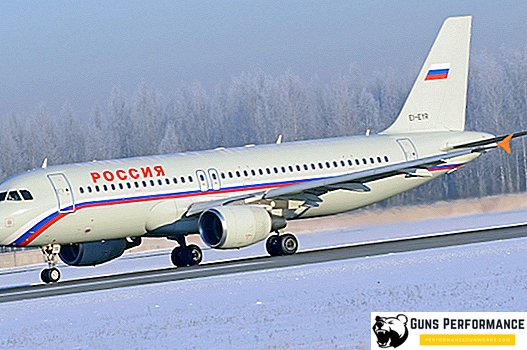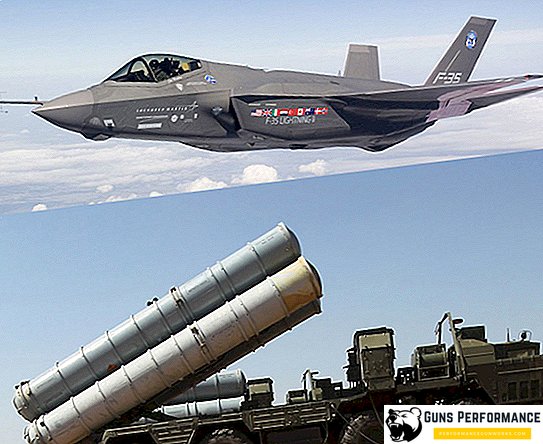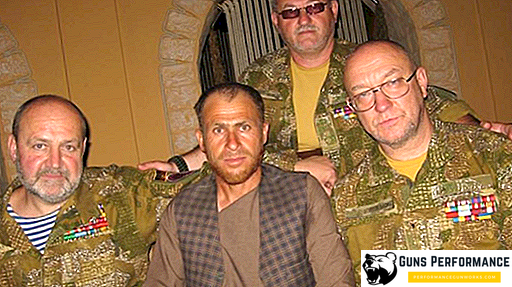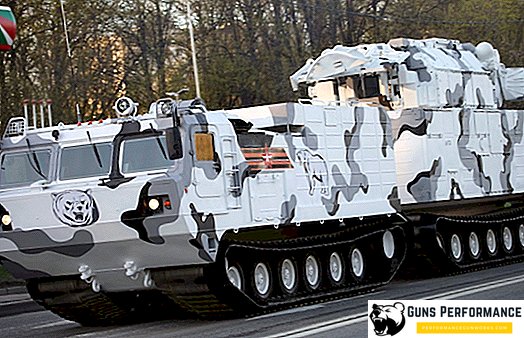In 1982, at the shipyard of the Nikolaev shipbuilding plant them. 61 Communards (Ukraine) in a ceremonial atmosphere was launched into the water missile cruiser project 1164 "Marshal Ustinov." This combat unit has become the second Atlant-type ship, built as part of the implementation of the State Defense Order. The new ship was named in honor of Marshal Ustinov Dmitry Fedorovich - Minister of Defense of the USSR 1976-1984.
Four years later, a new and powerful missile cruiser joined the Northern Fleet, receiving a permanent residence permit in the North Sea naval base. By that time, the Soviet missile cruisers of the project 1164, according to the NATO classification "Slava klass", were considered the most powerful, not aircraft-carrying, surface ships in the world. With a displacement of 9800 tons, the cruiser could reach a maximum speed of 32 knots. Armed with the Basalt anti-ship cruise missiles, the new Soviet ship posed a real threat to NATO aircraft carrier groups at sea. Western experts, assessing the combat capabilities of the new missile cruisers of the Soviet Navy, deservedly gave them the nickname “aircraft carrier killer”.
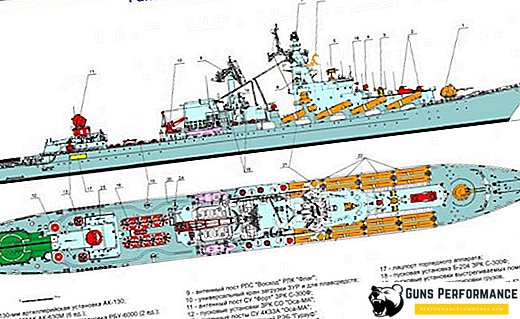
The full combat service of the Northern Fleet's surface ship began in the spring of 1987 and lasted until 1994, when the decision was made to put a military vessel for preventive maintenance.
From this point on, a new history of the warship began, which continues to be written in our days.
The first stage of modernization
Initially, the cruiser had quite decent tactical and technical characteristics and fully responded to the combat missions assigned to the Russian fleet. Until 1994, the cruiser actively participated in the combat life of the fleet, making long sea crossings. The ship was on combat duty in the Mediterranean, repeatedly visited the ports on the east coast of the United States and Canada. In 1994 it was decided to put the ship on scheduled preventive maintenance, which was delayed for three long years. Shipbuilders of the shipyard “Severnaya Verf” in St. Petersburg took up the restoration of the ship’s combat effectiveness. During this time, the ship touched the first major modernization.
The primary task was to tidy up the main building, reinforce components and assemblies of the propulsion system on the cruiser of project 1164 "Marshal Ustinov" and equip new fire extinguishing systems on board. A new, more powerful power plant was installed on the ship, capable of simultaneously providing an economical course and a quick transition to the forced mode. In addition to technological measures, the warship was to receive new weapons.
The main striking force of the RRC was the anti-ship cruise missiles "Basalt" (PKR-500). The missiles were located in 16 launch canisters, stationary on the upper deck. The flight range of the cruise missile was 500 km. At the same time, the rocket flew to the target along a complex trajectory, misleading the enemy’s radar and its entire air defense system. The mass of the missile warhead could reach 1000 kg. Despite the impressive combat parameters, by the mid-1980s, the B-500 RCC Bazalt stopped responding to the assigned tasks. The air defense systems of foreign fleets were equipped with new anti-missile systems capable of shooting down a Soviet missile during its marching flight at high altitudes.

The subsequent modernization of the missile led to the appearance of a new version of the anti-ship missile P-1000 Vulkan, which equipped the third ship of the RKR series Chervona Ukraine, now the missile cruiser of the Pacific Fleet Varyag. The naval command decided to re-equip the repaired warship with a new anti-ship P-1000 Vulcan system.

However, the modernization of the main strike weapons on the RKR Marshal Ustinov took place in a limited way. The installation on the vessel of more powerful cruise missiles was carried out without replacing the SM-248 launchers, which were not suitable for launching Vulcan cruise missiles in their standard configuration. Cruise missiles P-1000, equipped with starting engines from old Basalt missiles, arrived to equip the cruiser. Accordingly, the range of the new strike weapons remained at the same level. A new anti-ship complex on the second cruiser of the project 1164 turned out in a truncated form. They tried to increase the flight range of the new missile system by reducing the weight of the warhead, but this negated the combat effectiveness of this class of weapons.
To the note: On the third serial rocket cruiser Varyag the RCC Vulkan were initially mounted, therefore the launch containers were made of heat-resistant materials possessing a long resource.
With the new armament, the repaired cruiser of project 1164 "Marshal of the Soviet Union Ustinov" could be considered a fully combat-ready combat unit, an alternative to Orlan's 1144 heavy nuclear-powered missile cruisers. , cruisers and destroyers URO.
It should be noted that the modernization of the ship, carried out in the mid-90s, did not touch the air defense system at all. On the armament of the cruiser the main means of air defense remained only 8 launchers of a revolver type of anti-aircraft missile systems "Fort", created on the basis of the ground-based air defense system S-300. The near line of air defense was carried out by the old Osa-M air defense missile systems, which could solve only a limited number of combat missions. The reluctance to strengthen the means of dealing with the air threat is due to the need to introduce the cruiser into the fleet combat as soon as possible. Re-equipping the ship with new types of air defense could significantly slow down and so prolonged repair.

The modernized ship in the form in which it was again commissioned corresponded to the modern naval doctrine of the Russian Navy — powerful mobile strike forces of ships, concealed by naval and deck aircraft.
The combat service of the ship in modern conditions
Project 1164 ships, in particular Marshal Ustinov, the Moskva missile cruiser continue to make up today the strike power of the Russian fleet on the northern and southern flank, being part of the Northern and Black Sea Fleet. In the Far East continues to carry combat service RKR "Varyag", the third ship of the series.
In modern conditions, ships continue to be quite strong combat units, but in terms of radar and navigation equipment, missile cruisers constantly need improvements. In 2001 a new navigation equipment was installed on the cruiser Marshal Ustinov. The cruiser received the equipment of space communications and positioning, which greatly improved its combat capabilities.

The subsequent service of the ship was associated with overseas expeditions as part of the Northern Fleet carrier group and combat patrols in the northern Atlantic. The cruiser has repeatedly participated in the tactical and strategic exercises of the Northern Fleet. Intensive operation of the vessel led to real physical deterioration of structural elements. A number of other vital ship systems have fulfilled their technological resources. A new, overhaul of the ship began in 2011, when the cruiser once again moored at the factory wall of the CSR "Zvezdochka" in Severodvinsk.
The Supreme Naval Command decided to carry out another scheduled ship repair and, if possible, upgrade the ship. From November 2012, the land cruiser service began, which was put back on the stocks. Initially it was planned to carry out only preventive maintenance on the cruiser, but in the process of examining the state of the hull and the performance of the main components and assemblies, it became clear that the ship needed more thorough repairs.
Current state of affairs
During their stay on the slipway, the shipbuilders were able to restore the fire-fighting system of the vessel, put the knots and units of the propulsion unit in order. Shafts, propellers and pitching dampers were repaired on the vessel. The hull of the cruiser was completely cleared of old paint and repainted.
Upon completion of the works with the hull berths, the ship was again floated and transferred to the extension wall for subsequent repair work. As it turned out, the ship needed to replace more than 50% of all available ship communications. Modernization of basic communications, detection and navigation equipment has matured. As for the defensive complex of a combat ship, the work here was aimed at improving the technical condition of the Vulkan anti-ship missiles. After upgrading, the ship will have a full-fledged version of the Vulkan anti-ship missile complex, which can significantly enhance the cruiser’s combat power. The range of the missile with a normal warhead will be 1000 km.
Despite the fact that the repair work was supposed to end in 2014, in accordance with the terms of the state contract, the delivery of the ship was constantly postponed. Only in the fall of 2016, the Marshal Ustinov missile cruiser of the Atlant project 1164 began to undergo factory tests. The ship again arrived at the place of permanent deployment, where it was necessary to pass a complex of acceptance tests.

The latest news, which dazzles the domestic media, suggests that today the restored and repaired warship is a full-fledged combat unit of the Northern Fleet. The plans of the higher naval command was the decision to transfer the repaired cruiser to the Pacific Fleet to enhance the combat capabilities of the Russian Navy at the Far Eastern Naval Theater.
According to the latest data, the ATLANT-type 1164 missile cruiser is already listed as part of the Northern Fleet, having created, together with Peter the Great TARKR, the main strike force of the Russian Navy on the northern flank. New navigation equipment and means of detecting targets allowed to bring the ship in accordance with modern requirements for modern military ships.
The successes and results of the modernization of the Marshal Ustinov cruiser demonstrated wide technical possibilities for improving the ships of this project. The remaining RRC of project 1164, the cruisers "Moscow" and "Varyag" can be upgraded in a similar way. Such large-scale measures, according to the leadership of the Russian Navy, will not only extend the service life of combat ships of this class, but also enhance Russia's naval power in the Black Sea and the Far East.


